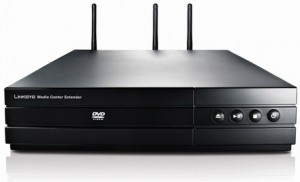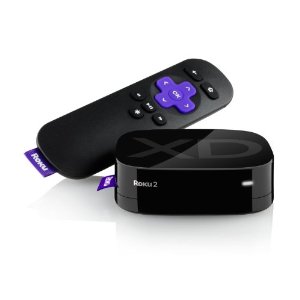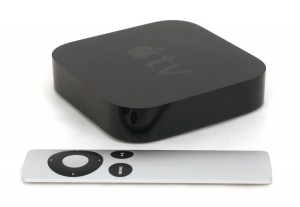I’ve long struggled to find the perfect media device for my home – something that can bring together the vast collection of digital media that I have saved mainly on my desktop computer.
For a while, I thought Microsoft’s Windows Media Center Extender idea was going to be the answer. So I bought one (made by Linksys) and tried to use it.

In the end, the Media Center Extender was… just OK. It was a little rough around the edges when used with Windows XP Media Center (the OS it was originally made for), but it got a lot better in Vista and Windows 7.
Still, this little device could only play media that my desktop computer knew about and had saved locally. It couldn’t play YouTube videos (or any other kind of on-line video, such as Netflix or Hulu), and it couldn’t play music I’d purchased through iTunes. It wouldn’t work at all if my PC was turned off, and it had difficulties with certain types of files – sometimes crashing the entire device, or even the Media Center service on my PC!
The final nail in the coffin for this little device though was that Microsoft eventually abandoned the idea, and manufacturers stopped making and supporting them.
It was around this time that I started looking for an alternative. For a long time I thought my only option would be to buy a very small slim PC and just hook that straight up to the TV – but I really didn’t like this idea, for a number of reasons.
As it would be a fully-fledged Windows PC, it would have all the problems of a Windows PC – needing to reboot for updates, needing to have a keyboard and mouse around, driver issues, etc.
Also, it would be rather expensive to buy an entirely new PC just to play back media – after all, the media itself would be stored on a different computer.
I briefly toyed with the idea of using an XBox or XBox 360 to do the same thing – after all, they function as Media Center Extenders as well – but buying a game console just to play back media seemed rather silly to me.
Eventually I narrowed it down to some sort of stand-alone device, specifically, a Roku or an Apple TV.
I decided to try the Roku first, as it was the (slightly) less expensive option – I got a refurbished one for just $75.

The Roku was a neat little device, but I quickly found that it was not going to do what I wanted:
- It had absolutely NO provision for streaming media from a local source (e.g., my computer), something that was infuriatingly difficult to determine from the online information (it was never made clear if it could or couldn’t).
- The UI for the device was a bit clunky, sharing that sort of slowness/lagging that the Windows Media Center Extender had – you’d press a button, and there’d be a slight delay before anything happened (especially noticeable if you tried to pause a movie).
- The remote was a special non-infrared device unique to the Roku, which means I could not use my universal remote with it.
In the end, I returned the Roku after just one day.
At this point, I wondered if I’d ever find something that could do what I wanted, and I seriously expected I’d have to buy a computer just to hook up to my TV. So it was with some trepidation that I walked into my local Apple store and bought an Apple TV (the 3rd generation model).

As with the Roku (and other similar devices), you just plug it into the power and into your TV (and, optionally, into your network – although it has wireless built-in) and you’re good to go.
Right away, I was very pleased with what I saw. If there is one thing Apple knows how to do, it’s design a simple, elegant, useable user interface – and the Apple TV is no exception.
The remote is a bit hard to get used to, as it looks like the scroll wheel from an iPod nano, but it isn’t – it’s just a 4 way controller – but this was a moot point for me, as the Apple TV works beautifully with my universal remote.
The Apple TV does exactly what I wanted it to do – it can play remote media, such as YouTube, Netflix, Hulu, or Flickr, and it can also play music, movies, and pictures from my local computer – all in full 1080p HD quality. And all this for just $99 – what a deal!
Of course that’s not to say the Apple TV doesn’t have its downsides – because it certainly does – but they are at least much more bearable than the downsides of the other options.
The biggest downside (at least for me) with the Apple TV is that in order to stream media from a local PC, you have to use iTunes – that is, you have to leave iTunes open on your computer all the time (or, whenever you want to be able to stream media to your Apple TV). And sometimes, even if iTunes is open, the Apple TV won’t connect to it.
On top of that, iTunes is very picky about what types of files it will play, especially when it comes to videos. If you’re a Windows user and you have a lot of AVI files (as I do), be prepared to have to re-encode all of your videos into MP4 format, because iTunes (and the Apple TV) pretty much will not play anything else.
Also, iTunes is… not that great about letting you organize videos (not surprising, as it was originally designed as a music program, not a video program). It can be done, but it’s slow and awkward – pretty much par for the course when it comes to iTunes, though.
That said, the Apple TV is a nice little media device, and it also has a few neat tricks up its sleeve – for example, if you turn on AirPlay, you can use your Apple TV as a remote set of speakers, so you can stream something from iTunes or your iPod Touch/iPhone directly to your Apple TV. Since I hooked up my home stereo (via optical cable) to the Apple TV, this means I can now fulfill part of my childhood dream to have music playing throughout my home.
You can also use “AirPlay Mirroring” to mirror your iPhone’s screen to your TV through the Apple TV – although you do need to be using at least an iPhone 4S for this to work, otherwise you’ll only be able to display some things (videos and photos). If you have a Mac and the latest version of OS X, you can use this to make your TV a remote second monitor – which is a pretty neat trick, if you ask me! (Sadly, there is no ability to do this from Linux or Windows, although for Windows there is a 3rd party program that can kind-of make it work, although there is some very serious lag to the display.)
Still, of all the media playback devices I’ve found and tried, the Apple TV is the best balance of function, form, and price… so much so that after a few months with it, I went out and bought a 2nd one for my bedroom TV!
These days, every new TV or DVD (sorry, Blu-Ray) player seems to have some sort of media playback options built in – but oftentimes these are afterthoughts, poorly executed and with horrible UI that is never updated or improved. The Apple TV, at least, is purpose-built for what it does, and has a typically Apple-ish polished UI that actually is updated (and even if it isn’t, it’s so well done to begin with – it’s like the iPod; if you get the basics right the first time, you don’t need to keep “fixing” it).
The Apple TV’s combination of (almost) perfect function, small size, good UI, and low price, make it the perfect choice for home entertainment – or, at least they do for me, anyway. If you’re looking for a media device, you might want to give the Apple TV a try… you might just be surprised.